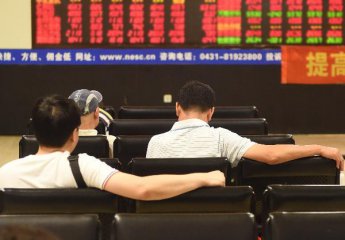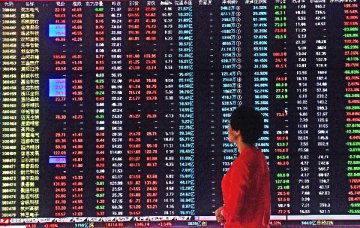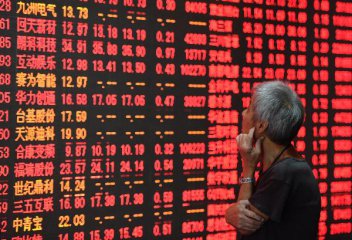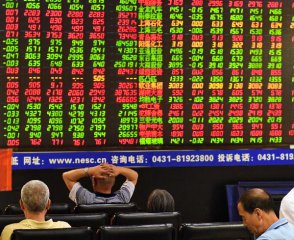
China’s A-share market sees a good start yesterday, the first trading session of the fourth quarter. The SSE Composite Index witnessed the highest one-day surge since August 15 and again stood above the 60-day weighted moving average. The journalist learnt that sentiment on the market boosted after the National Day Holidays, but it overall remains rational. After various local governments intensively issued home-purchase restriction policies, professional investors and analysts diverge on the capital flow squeezed from the housing market. However, they are in general optimistic about an October rebound of the stock market.
Yesterday, the SSE Composite Index opened 16 points higher. Later, it pulled back due to decline of stocks in the real estate industrial chain such as property, decoration, cement and construction material stocks. Subsequently, major indexes started to surge amid fluctuations, with most industrial sectors went higher. The SSE Composite Index gradually climbed from the lowest level of 3,014.6 points to the territory near 3,050 points. It remained in that region and closed at 3,048.14 points, representing an increase of 1.45 percent. The ChiNext Board closed at 2,208.47 points, up 2.72 percent. The intraday turnover of the Shanghai and Shenzhen bourses totaled 454.4 billion yuan yesterday, rising significantly than the no more than 300 billion yuan before the National Day Holidays.
“The overall surge of the market is a good thing. As we focus on individual stocks, we would not go long or short sharply due to near term fluctuation of the market, but some of my friends have already started to aggressively increase position,” an investment manager of a private equity fund told the journalist.
Responsible person of the wealth management center of a securities company says that as some investors inclined to hold cash during the holidays, in order to avoid black swan events during the long break, the stock market usually sees net cash inflow after long holidays.
During the National Day Holidays, various local government announced home-purchase and mortgage loan restrictions, which resulted in the daily trading turnover of new homes in most cities to decline sharply. Many investors therefore linked the strong rebound of the stock market to the squeeze of capital in the housing market. However, whether there is see-saw effect between the housing market and the stock market? Professional investors hold divergent opinions on this question.
Rosefinch Investment, a well-known private equity fund, is in the view that regulatory policies on real estate has to some extent eased the concern of risks in the real estate market earlier, optimists expect the capital to flow into the stock market, and contribute to the capital quantity of the stock market; pessimists worry that the downturn of real estate will impact the economic fundamentals. It is estimated that factors in these two sides all existed, but in the near term, the impact is limited. In general, the adjustment in real estate market would not likely to change the trend of the stock market, but it in turn could affect sectors and styles of the stock market.
“Restriction policy on the housing market would not have much impact on our investment strategy, since we have already taken into account of risks come from adjustment in the housing market, and didn’t have much allocation in relevant sectors. In the future, we will take full consideration of risks resulted from downturn of the real estate industry,” said Gang Dengfeng, fund manager and strategist with Orient Securities Asset Management Company Limited.
Mao Yu, managing partner of Shanghai Quantitative Investing Management Center (LP) also told the journalist that its investment strategy has no substantial change at present. The company still invests according to existing quantitative analysis. The correlation between the housing market and the A shares cannot yet be reflected by quantitative analysis. The current restriction policy on housing market would not lead the company to adjust its asset allocation in the A-share market.
Investment adviser of the sales department of a securities company also told the journalist that not many of its clients bought in more shares yesterday and nearly half of the clients keep bear position. Those clients holding positions usually have high position and the current prices of shares are lower than the buying prices.
In comparison, analysts of some securities companies are more optimistic. Dai Kang, chief strategist of Huatai Securities pointed out in the research report that the real estate adjustment policies of local governments reflect structural adjustment instead of aggregate adjustment, which have double see-saw effects on the A-share market: firstly, in the circumstance when low interest rate environment remain unchanged, the squeeze of real estate capital can help A shares to obtain re-allocation of liquidity; secondly, under the background where supply-side reform and demand-side management are both emphasized, fiscal policy might be implemented to hedge the decline of real estate investment.
Some institutional investors are stand on the sidelines. “Adjustment policy on the housing market may weaken the housing market’s attraction to stock market capital, which instead enhanced the attraction of the stock market to large assets. But whether the capital will flow into the stock market still need to be observed,” said Deng.
Many institutions and analysts give optimistic expectation for the stock market in the future, and believe that the rebound of the stock market is still opening.
Zhao Yang, strategist of Everbright Securities, says that A-share market has sufficient capital supply. What it lacks are the effect of making money and enhancement of enterprise value. In a broader sense, slight economic recovery pushed by low inventory can last for a while. At the same time, the overall valuation of A-shares is still at a reasonable region, and the market is likely to rebound.
Wang Mingli, strategist with Guoyuan Securities, also believes that the market will experience an upward trend in the near term. When the liquidity is sufficient, the bottoms of the stock market will gradually raising. At present, the market is likely to see a good opportunity during the year.
As to the investment directions, the strategy team of Huatai Securities suggests investors fix on pure infrastructure construction stocks, and upper-stream raw material sectors in infrastructure construction which is less sensitive to real estate, since such stocks will directly benefit from the implementation of fiscal policy. Wang believes that from the perspective of re-valuation, it is estimated that blue-chip stocks will continue to be highlights. While the hot spots are likely to expand to more industries, such as food, construction industry, airport and airline, and form sector rotation.
As for the risks that may emerge in the future, Zhao pointed out that the core risks still concentrate on exchange rate fluctuation, rising of risk-fee interest rates and the end of recovery cycle of corporate profit. This upcoming December and first quarter of next year is an important observation period.
Translated by Adam Zhang























Latest comments